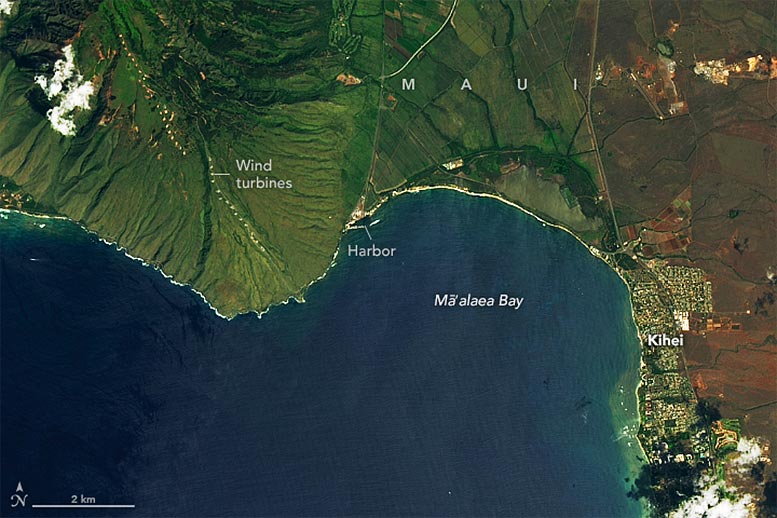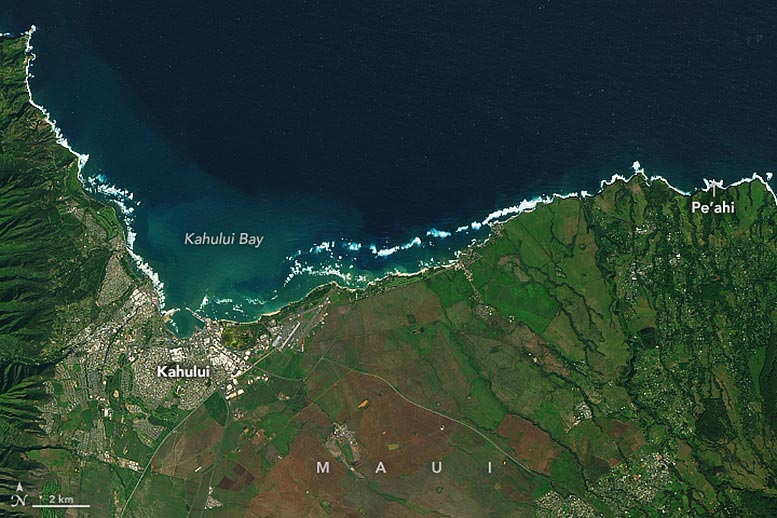When large waves break in Māʻalaea Bay, they do so with the crushing speed of a freight train.
“Freight Trains” and “Jaws” may sound like summertime movie blockbusters, but the names belong to two of Maui’s most iconic waves. They are revered by surfers for good reason. Freight Trains has been called one of the fastest surfable waves in the world, while Jaws is better known for big-wave surfing.
The surf break known as “Freight Trains” rips across Māʻalaea Bay on Maui’s southern shore. However, surfers say that the substantial, surfable break here is relatively rare. Conditions need to be just right: specifically, large waves must approach the bay from the perfect south or southeasterly direction.
The large waves, or swells, are typically generated in the southern hemisphere during winter, when large storms brew in the southern Pacific Ocean. The waves can travel thousands of miles, crossing the equator and eventually reaching Maui’s southern shore, where it is summer. But the waves can lose energy along the way as they encounter numerous island chains in the South Pacific.
The foam produced by breaking waves shows up in satellite images as a white strip close to the shore. In the image above, acquired on October 3, 2018, with the Operational Land Imager (OLI) on Landsat 8, a small amount of foam is visible near the harbor. The late season waves were probably influenced by Hurricane Walaka, a category-4 storm centered about 750 miles (1,200 kilometers) west of Māʻalaea.
The strength of offshore winds also matters. Gentle offshore winds support the wave front, helping create the smooth, steep face that surfers seek. But offshore winds that are too strong can prevent a wave from breaking at all. In Māʻalaea, located on the island’s leeward side, strong trade winds from the north are accelerated as the air is forced between the peaks of Mauna Kahalawai (west) and Haleakala (east). (Notice the wind turbines in the image above, poised to take advantage of this so-called Venturi effect.)
On the occasions when waves in Māʻalaea Bay do break, they do so with crushing speed like a freight train. Surfers ride inside the barreling wall of water, pumping their boards to keep up with the speeding wave. According to Justin Stopa, a scientist at the University of Hawaiī at Mʻanoa, the speed has a lot to do with the dramatic transition of the seafloor from deep water to shallows. Strong currents in the bay, possibly enhanced by the harbor, can also make the wave break faster.
When waves are ripping in Māʻalaea Bay, conditions are typically quiet off the island’s northern shore—that is, until winter, when storms are brewing in the North Pacific. Winter weather systems in the basin generate the swell that marches toward Maui’s northern shore. Unimpeded by other island chains, they retain more energy during their shorter journey and produce the island’s famously large winter waves.
Notice the significant amount of foam from breaking waves visible in this image, acquired on December 15, 2021, with Landsat 8. Peahi, at the right side of the image, is near the especially large break known as Jaws. Waves here can grow as high as 70 feet (20 meters).
“These are some of the largest—rideable and accessible—waves on the planet,” said Stopa, who studies winds, waves, and climate. He is less sure, however, about Freight Train’s claim to fame as the “fastest” wave. “I think this is based on the surfer’s experience with surfing the wave rather than an objective approach based on observations.”
NASA Earth Observatory images by Lauren Dauphin, using Landsat data from the U.S. Geological Survey.











Be the first to comment on "Maui’s Iconic Waves Break With the Crushing Speed of a Freight Train"